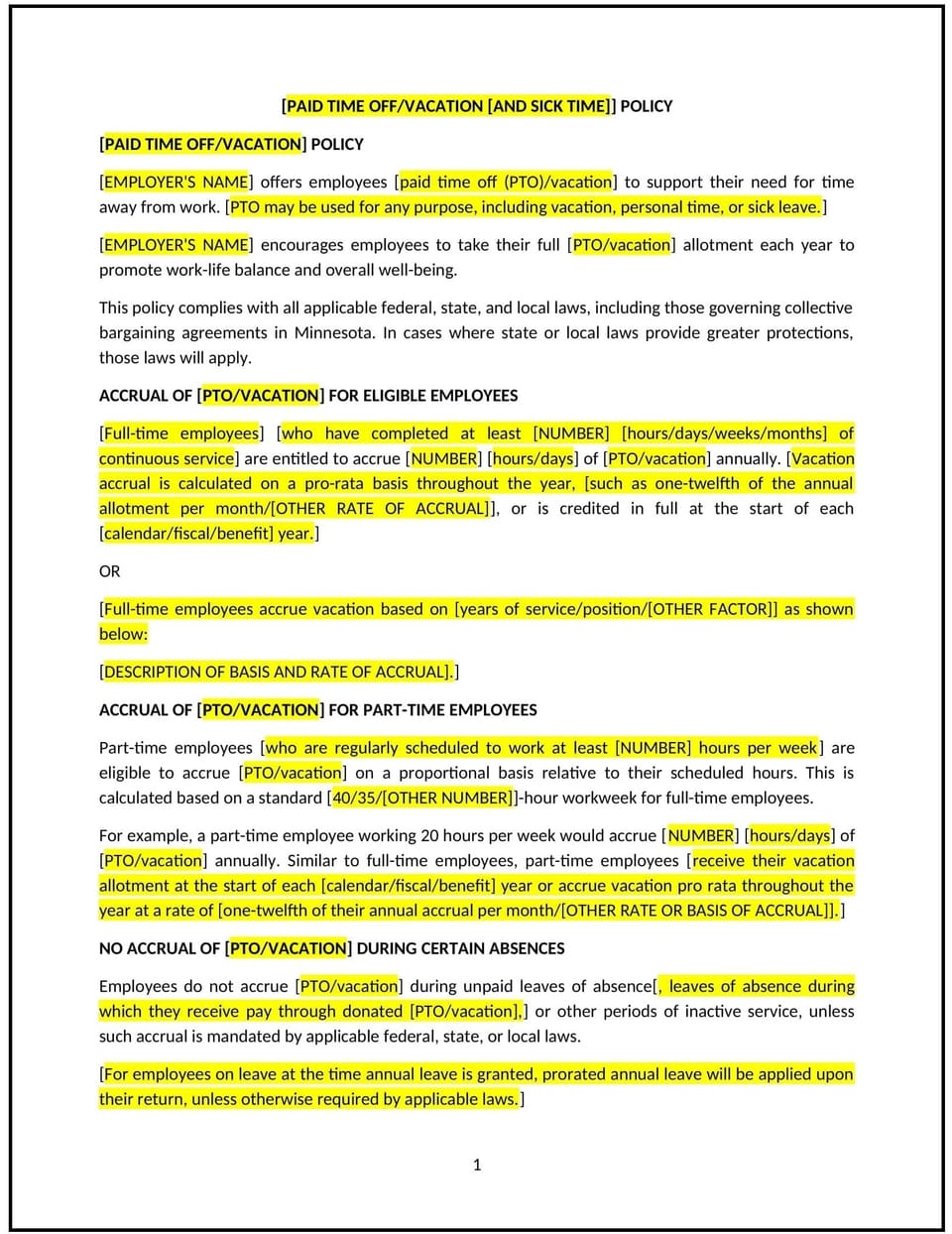Vacation policy (Minnesota): Free template

Vacation policy (Minnesota)
This vacation policy is designed to help Minnesota businesses provide clear guidelines on how employees can accrue, request, and take vacation time. The policy ensures employees have the opportunity to recharge and maintain work-life balance while addressing the operational needs of the business.
By implementing this policy, businesses can promote employee well-being, improve morale, and maintain consistency in managing vacation time across teams.
How to use this vacation policy (Minnesota)
- Define accrual rates: Specify how vacation time is accrued, whether it is based on hours worked, length of employment, or a fixed annual allowance. Include details for full-time, part-time, and temporary employees.
- Explain carryover and expiration rules: State whether unused vacation time can be carried over to the following year or if it expires at the end of a specific period. If carryover is allowed, include the maximum number of hours or days.
- Establish a request process: Provide clear instructions for employees on how to request vacation time, including how much notice they need to give and the approval process. Specify if vacation requests must be submitted in writing or through a specific system.
- Address peak periods: Identify any blackout dates or peak periods where vacation requests may be limited due to operational needs. Outline how conflicts between overlapping requests will be resolved.
- Include payout rules: Indicate whether unused vacation time will be paid out upon termination of employment, and if so, explain the calculation method in alignment with Minnesota law.
- Ensure equitable treatment: Make sure the policy applies consistently to all eligible employees, with no discrimination or favoritism.
- Encourage proper use of vacation time: Promote the importance of taking time off to recharge, supporting employee health and well-being.
Benefits of using this vacation policy (Minnesota)
Implementing this policy provides several advantages for Minnesota businesses:
- Promotes employee satisfaction: A clear vacation policy helps employees understand their rights and opportunities for time off, improving morale and retention.
- Enhances productivity: Employees who take regular vacations are more likely to return refreshed and motivated, contributing to higher productivity.
- Reduces conflicts: Well-defined procedures for requesting and approving vacation time minimize misunderstandings and conflicts among team members.
- Supports compliance with Minnesota law: Aligning the policy with state regulations ensures that employee rights regarding accrued vacation time are respected.
- Reflects Minnesota-specific considerations: The policy can be tailored to address local practices, including unique seasonal needs or industry-specific challenges.
Tips for using this vacation policy (Minnesota)
- Communicate clearly: Ensure that all employees are aware of the vacation policy and understand the rules for accruing and using vacation time. Provide training for managers to apply the policy consistently.
- Monitor balances: Regularly track vacation accrual and usage to ensure accuracy and avoid issues related to unused time or excessive requests.
- Encourage planning: Encourage employees to plan their vacation well in advance to minimize disruption to business operations.
- Be flexible: While maintaining operational needs, be as accommodating as possible to employee requests, fostering a positive work culture.
- Review regularly: Periodically review the vacation policy to ensure it aligns with Minnesota law and continues to meet the needs of the business and its employees.
Q: How is vacation time accrued?
A: Vacation time is typically accrued based on hours worked, length of employment, or as a fixed annual allowance. Businesses should specify the accrual method and any differences for part-time or temporary employees.
Q: Can unused vacation time be carried over to the next year?
A: Businesses should define whether vacation time can be carried over and set a limit on the number of hours or days that can be carried forward, if applicable.
Q: What is the process for requesting vacation time?
A: Employees should submit vacation requests in writing or through the company’s designated system, providing adequate notice. Businesses should outline how approvals are handled and any considerations for overlapping requests.
Q: Are there blackout dates for vacation requests?
A: Some businesses may have peak operational periods where vacation requests are limited. Employees should be informed of these periods in advance to plan accordingly.
Q: What happens to unused vacation time upon termination?
A: Businesses should clarify whether unused vacation time is paid out upon termination and, if so, how the payout is calculated, consistent with Minnesota law.
Q: How should conflicts between vacation requests be handled?
A: Businesses should establish a fair process for resolving conflicts, such as prioritizing based on the order of request submission or seniority.
Q: Can employees take unpaid vacation if they have no accrued time left?
A: Businesses should specify whether unpaid vacation is allowed and under what circumstances, ensuring consistency in decision-making.
Q: How often should this policy be reviewed?
A: This policy should be reviewed annually or whenever there are changes in Minnesota’s employment laws or the business’s operational needs.
This article contains general legal information and does not contain legal advice. Cobrief is not a law firm or a substitute for an attorney or law firm. The law is complex and changes often. For legal advice, please ask a lawyer.


